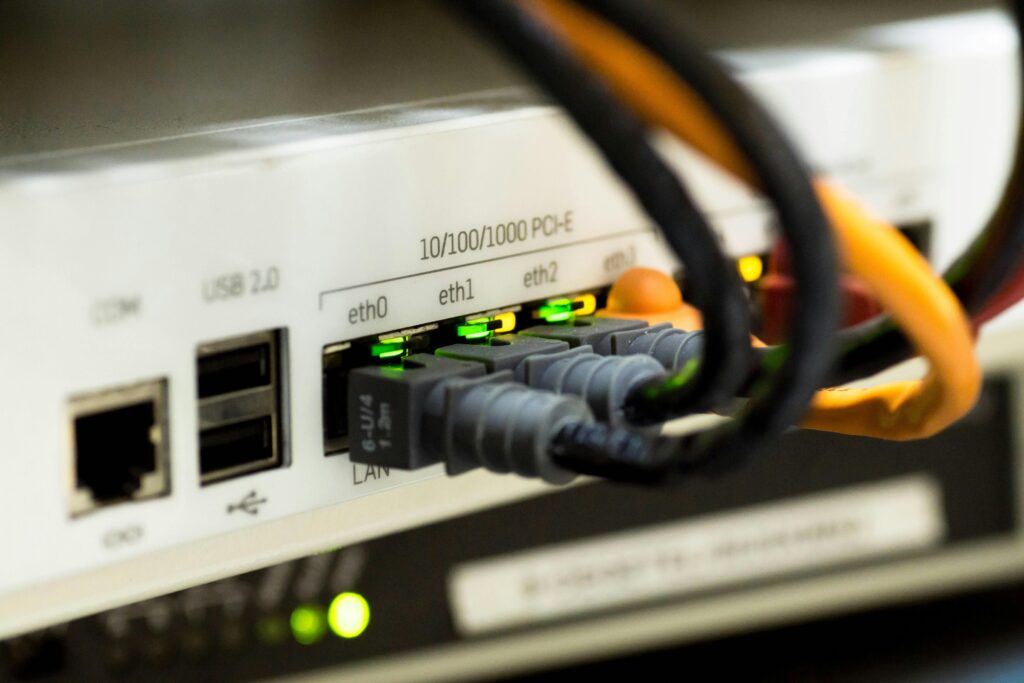
How to Protect Your Network from Denial of Service (DoS) Attacks
Malicious hackers aren’t always after your data…
Sometimes, they just want to cause chaos for your business.
They aim to disrupt your operations, throw your services into turmoil, and drive your customers away, all so they can extort you!
Denial of Service (DoS) and Distributed Denial of Service (DDoS) attacks are classic examples of this approach.
These attacks don’t steal information or compromise data integrity.
Instead, they focus on overwhelming your servers, websites, services, or networks with a flood of internet traffic, leaving them unable to function properly.
Key signs of a DoS attack include:
- Sluggish performance or complete unresponsiveness.
- Inability to access websites or applications.
- An unexplained spike in network traffic.
- A email threatening blackmail and extortion
While these attacks don’t target your data directly, the damage they cause can be severe: prolonged downtime, financial losses, and frustrated customers.
The intent is simple: to make your systems unavailable exactly when you need them most.
What’s in it for them?
Understanding attacker motivations can help you predict and prevent DoS attacks. Hackers typically launch these attacks for:
Financial gain – Cyber Criminals often use DoS attacks as leverage for ransom demands, threatening to continue disruption unless payments are made.
Hacktivism – Activist groups may target organisations whose policies they oppose, using service disruption as digital protest.
Competitive advantage – Some attacks are commissioned by unethical competitors seeking to damage rivals and redirect frustrated customers.
Distraction tactics – DoS attacks can overwhelm IT teams while attackers attempt more subtle intrusions elsewhere in the network.
DoS vs. DDoS: What’s the difference?
Before diving into defence strategies, let’s take a look at the 2 main forms of attacks:
- DoS (Denial of Service): These are singular attacks originating from one source aiming to flood your network with traffic or exploit vulnerabilities.
- DDoS (Distributed Denial of Service): These involve multiple sources – often botnets – coordinating an assault, making them harder to detect and block.
The key difference lies in scale and complexity. DDoS attacks often require more robust solutions due to their distributed nature.
I’ll just deal with it when it happens!
Just to note, whilst many DoS protection providers such as Cloudflare will assist when a DoS attack is taking place, there are considerable costs associated (as the providers know you are in a desperate situation) and even then, it will take time for the protections to kick in.
Now that we know what we’re up against, let’s dive into 8 practical strategies to protect your organisation from DoS-based attacks.

1. Network Monitoring and Traffic Analysis:
To combat these threats, visibility into your network (physical and cloud based) is vital.
After all, how can you address a threat if you don’t even know it exists?
Set up 2 things:
- Real-Time Monitoring: Advanced Threat Detection: Use tools that leverage machine learning and behavioural analysis to detect anomalies and potential threats in real time. Network Behaviour Monitoring: Continuously monitor traffic patterns to identify deviations from normal activity, which may signal emerging threats.
- Regular Audits: Conduct regular traffic analysis and vulnerability assessments to identify weak spots. For instance, financial institutions might deploy AI-based tools to detect atypical transaction volumes.
Note: Tailor your monitoring and detection system to your industry.
For example, financial institutions can use AI-powered tools that flag unusual transaction volumes as potential threats.
On the other hand, healthcare organisations must safeguard against irregular access patterns to patient portals.
The earlier you detect unusual activity, the more effectively you can respond.
2. Rate Limiting and Traffic Filtering:
Managing traffic flow is key to preventing your network from being overwhelmed.
Even legitimate traffic can cause problems during unexpected surges.
Imagine trying to buy tickets for a massively popular concert – everyone’s refreshing the page at once, and the system crashes.
Denial of Service (DoS) attacks exploit this exact principle, only their goal is to shut your business down.
Here’s 2 ways to reduce the impact of mass traffic.
- Rate Limiting: Set limits on the number of requests a single IP address can make within a given timeframe. By capping these requests, you can stop malicious actors from flooding your servers with traffic.
- Traffic Filtering: Use filters to block known malicious traffic before it reaches critical systems. These are typically provided by 3rd parties, such as CloudFlare and AkamaI, which have extensive networks to identify and block malicious traffic before it reaches your systems.
For example, e-commerce platforms often face bot-driven DDoS attacks that aim to disrupt operations or scrape data.
By combining rate limiting and traffic filtering, these platforms can significantly reduce the risk and maintain a smooth experience for legitimate customers.
3. Web Application Firewalls (WAFs):
A Web Application Firewall (WAF) examines incoming traffic and filters out malicious requests.
It examines every incoming request – headers (metadata), payloads (data being sent), and behaviour – to block anything suspicious.
Here’s 3 common cyber attacks WFAs protect against:
- SQL Injections: These attacks exploit vulnerabilities in input fields, like login boxes or search bars, to insert malicious code. If successful, hackers can bypass security and directly access or manipulate the database.
- Cross-Site Scripting (XSS): Stops the injection of malicious scripts into web pages viewed by users. Hackers use XSS to steal sensitive data, hijack sessions, or spread malware by targeting vulnerabilities in input fields or web applications.
- Credential Stuffing: This attack uses stolen login credentials, often obtained from data breaches, to try and access user accounts. Hackers rely on automated bots to test thousands of username-password combinations across multiple sites, exploiting users who reuse credentials.
Deploying a WAF can help block malicious traffic aimed at disrupting web applications, especially layer 7 DDoS attacks.
Layer 7, also known as the application layer, is where user interactions happen (logging in, loading pages, or submitting forms).
Attacks here are designed to overwhelm these critical functions, crippling the services your users depend on.
So, for organisations that rely on online portals, e-commerce platforms, or any customer-facing services, a WAF is a necessity.
4. Load Balancing:
Load balancing is about ensuring no single server bears the brunt of incoming traffic.
If one server starts struggling, the load balancer shifts traffic to other servers.
This keeps things running smoothly for legitimate users during traffic spikes and minimises the effects of a DoS attack.
You can also set it up to balance traffic across backup servers, which is particularly useful with providers like Azure or AWS. However, be cautious, as costs can increase during traffic surges if resources scale excessively.
For instance, financial services processing time-sensitive transactions rely on this setup to ensure uptime, even if one data centre faces issues.
In short, load balancing keeps your systems up and running, no matter how much traffic comes your way.
Top Tip: Combine load balancing with automatic scaling to handle high traffic surges, such as promotional events like Black Friday.

5. Content Delivery Networks (CDNs):
A Content Delivery Network (CDN) is a network of servers strategically placed to make your website faster and more secure.
Instead of every user’s request hitting your main server, a CDN stores copies of your content – like images, videos, and web pages – on servers all over the world.
This process is called caching.
When someone visits your site, they get the content from the server closest to them. It’s faster, smoother, and puts less strain on your main system.
But a CDN isn’t just about speed.
It’s also a great way to defend against DDoS attacks.
A CDN spreads traffic out across its network so no single server gets overwhelmed. Thus reducing the likelihood that a DoS attack will overwhelm any single point.
Think of them as an extra layer of load balancing.
Some CDN providers also offer DDoS protection with features like traffic scrubbing, which filters out harmful traffic before it even reaches your servers.
A CDN keeps your website fast, available, and secure – even when traffic spikes or cyberattacks come your way.
6. Redundancy and Failover Systems:
Here’s a timeless piece of advice…
Always backup your data.
Redundancy is your best protection against disaster, natural, accidental or malicious!
But what exactly does redundancy mean? In simple terms, it’s having backups or alternatives in place so that if one part of your system fails something else can take over to keep things running.
There are two main ways to implement it:
- Backup Systems and Alternate Servers. These act as stand-ins. If your main system goes down, you have backups or secondary servers that can take over. (These can be onsite, cloud based or handled by a 3rd party).
- Failover Systems. When one server fails, a failover system redirects traffic to another working server without you having to do anything.
The key is to tailor these systems to your business needs.
For example, financial institutions can’t afford downtime, so they rely on alternate transaction-processing systems to maintain service during an attack.
One last tip: test your failover systems regularly to ensure they actually activate during an attack.
7. Incident Response Plan:
Having a plan in place makes all the difference when a DoS attack strikes.
Without one, things can quickly spiral out of control, but with a clear strategy, you can minimise the damage and bounce back fast.
Here’s what a solid plan should cover:
- How to Stop the Attack: Outline the steps to identify, isolate, and deal with the attack quickly.
- Who to Inform: Make sure everyone knows how to communicate with key stakeholders – your team, customers, and any external partners.
- How to Get Back Online: Include a clear process for restoring normal operations, like switching to backups or using failover systems.
And don’t forget about disaster recovery.
If the worst happens and your systems go down, having a step-by-step recovery plan (if you don’t have one already, contact us now to discuss) ensures you can get your systems and applications back up and running fast.
Test your plan regularly so your team knows what to do when it counts. A well-rehearsed plan means less stress and more control when things go sideways.
8. Partner with a Managed Security Services Provider (MSSP):
Defending against DDoS attacks can be tough, especially if your team is already stretched thin.
That’s where a Managed Security Services Provider (MSSP) comes in.
These experts can take the pressure off your internal team while giving your network an extra layer of protection.
Look for a provider that offers comprehensive DoS protection services, including monitoring, detection, and mitigation, so you’re covered from all angles.
When choosing an MSSP, consider their industry-specific experience. For example, in retail, an MSSP with expertise in Payment Card Industry (PCI) standards can be a valuable partner.
Partnering with an MSSP gives you peace of mind knowing that experts are watching over your network.
Audit Your Current Defences
Take a closer look at your DoS protections.
Use the strategies above to identify any weak spots, uncover vulnerabilities, and find gaps in your response plan.
By putting these steps into action, you’re not just protecting your organisation from the financial, operational, and reputational damage of an attack – you’re also setting the foundation for better cybersecurity overall.
Understanding where you’re at now is the first step toward a more secure system.
Whether you need stronger defences, smarter detection systems, or just expert advice, we’ve got you covered.
At Cyber Alchemy, we specialise in creating customised solutions that fit your organisation’s unique needs.
Ready to secure your organisation against DoS attacks and more? Contact us today to start building a more secure future for your business.